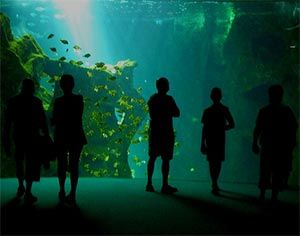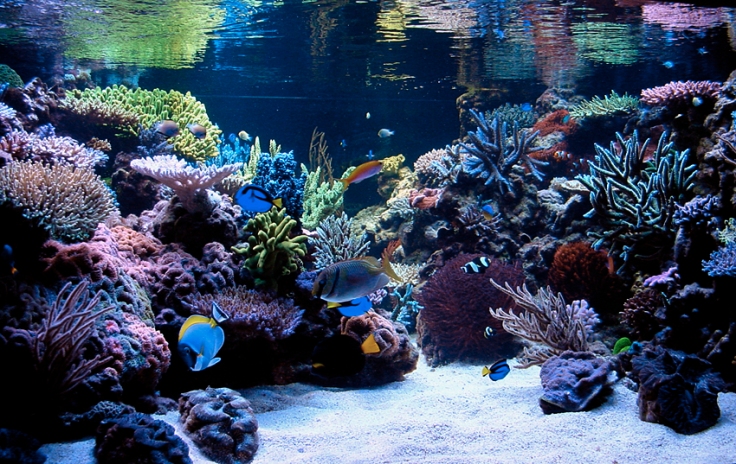Un poquito de historia.
El origen de la acuariofilia es muy antiguo. Los antecedentes de cultivo de peces, en especial carpas, se remonta a los sumerios, y más tarde a los romanos, que ya utilizaban estanques para mantener peces vivos destinados al consumo. Ha llovido bastante desde entonces.
En 1750 se introdujeron por primera vez en Europa los primeros peces de colores vivos. Pero hasta el siglo XX no se intentó la cría de peces tropicales. Para el año 1930, el acuario se empezó a convertir en un objeto de decoración en algunos hogares y lugares públicos.
Los primeros acuarios marinos fueron de solo peces. Ya os imagináis, peces payaso y alguna damisela malhumorada. Unos principios muy básicos.
Los iniciados pronto se dieron cuenta que a diferencia de la acuariofilia dulce, los peces marinos eran algo más delicados. Más sensibles a las variaciones de su medio, cosa que en un hábitat de pequeñas dimensiones, no pone las cosas precisamente fáciles. Luego por otro lado estaba el tema de la salinidad del agua, bien con sales sintéticas o dando viajes a la playa más cercana. La cosa se ponía complicada. Pero cuantas veces eso es precisamente lo que engancha al ser humano, ¿verdad?
A little bit of history The origin of the aquarium is very old. The history of fish farming, especially carps, dates back to the Sumerians, and later to the Romans, who already used ponds to keep live fish for consumption. It has rained quite a lot since then. In 1750 the first brightly colored fish were introduced for the first time in Europe. But until the twentieth century the breeding of tropical fish was not attempted. By 1930, the aquarium began to become a decorative object in some homes and public places.
The first marine aquariums were only fish. You already imagine, clown fish and some bad-tempered damsel. A very basic principles.
The initiates soon realized that unlike the sweet aquarium, the marine fish were somewhat more delicate. More sensitive to the variations of their environment, which in a small-sized habitat, does not make things exactly easy. Then on the other hand there was the issue of the salinity of the water, either with synthetic salts or giving trips to the nearest beach. Things got complicated. But how many times that is precisely what engages the human being, right?

El boom de la afición marina llegó a finales de los años 80. Primero con la posibilidad de la cría de peces, luego la evolución de la tecnología aplicada a la afición, así como mejoradas sales marinas, hizo que la afición despegara. Echando la vista para atrás, uno se acongoja de como ha avanzado todo esto. Y sigue aún haciéndolo.
Pero entremos en materia. Fue a finales de los años 70 cuando se revolucionó esta afición. En concreto en Alemania, donde inventaron el sistema de filtración Berlín. ¿De qué se trata? Pues del sistema de filtración que actualmente todavía es el más usado por la buena fiabilidad que conlleva. Desde su descubrimiento, permitió a todos sus aficionados la posibilidad de mantener especies delicadas que hasta entonces había sido imposible. Este método basa su funcionamiento en la eliminación de los sistemas de filtrado convencionales: Filtros seco-húmedos, presurizados y otros que se consideran por muchos como fabricas de NO3 y PO4.
El peso del filtrado se produce en la roca viva que supone un excelente sistema de filtrado biológico natural y al espumador de proteínas (skimmer) que al tratarse de un dispositivo de alto rendimiento, filtra gran cantidad de residuos orgánicos mediante separación fraccionada de la espuma producida en una columna, por la cual pasa continuamente el agua del acuario. El espumador normalmente va colocado a un sumidero (sump) por debajo de la urna principal.
Conviene recalcar que el método Berlín es solo aplicable a acuarios de arrecife. Los acuarios denominados de «solo peces» o «mixtos», el trabajo de filtrado sigue recayendo en los sumps lo más grandes posibles, junto al espumador de proteínas, con sus correspondientes sistemas de circulación en el interior del tanque principal.
La tendencia actual en acuarios de arrecife es la de limitar el número de peces e incrementar el volumen de la roca viva y de otros invertebrados (corales, anénomas, tridacnas, etc.).
Aparte del skimmer que comentaba antes, algunos complementos tecnológicos importantes en un acuario marino son la iluminación de alta intensidad y espectro continuo, ahora actualmente con pantallas de LED.
Siendo la historia la más sabia de todas las experiencias, el sistema que todavía desarrollamos sigue siendo el mismo. Si bien ahora se ha perfeccionado con reactores externos, refugios y una tecnología mejorada, la base del éxito sigue siendo la misma.
The boom of the marine fans arrived at the end of the 80s. First with the possibility of raising fish, then the evolution of the technology applied to the hobby, as well as improved marine salts, made the fans take off. Looking back, one is distressed of how all this has advanced. And still doing it. But let’s get into matter. It was in the late 70’s when this hobby was revolutionized. Specifically in Germany, where they invented the Berlin filtration system. What is it about? Well, the filtration system that is still currently the most used because of the good reliability it entails. From its discovery, it allowed all its fans the possibility of maintaining delicate species that until then had been impossible. This method bases its operation on the elimination of conventional filtration systems: dry-wet, pressurized filters and others that are considered by many as NO3 and PO4 factories. The weight of the filtrate is produced in the living rock, which is an excellent natural biological filtering system and the skimmer, which as a high-performance device, filters large amounts of organic waste by fractional separation of the foam produced. in a column, through which the water of the aquarium continually passes. The skimmer is usually placed in a sump below the main ballot box. It should be noted that the Berlin method is only applicable to reef aquariums. The so-called «only fish» or «mixed» aquariums, the filtering work continues to fall on the largest sumps possible, together with the protein skimmer, with their corresponding circulation systems inside the main tank. The current trend in reef aquariums is to limit the number of fish and increase the volume of live rock and other invertebrates (corals, anénomes, tridacnas, etc.). Apart from the skimmer that I mentioned before, some important technological complements in a marine aquarium are high intensity lighting and continuous spectrum, nowadays with LED screens. As history is the wisest of all experiences, the system we still develop remains the same. Although it has now been refined with external reactors, shelters and improved technology, the basis of success remains the same.
